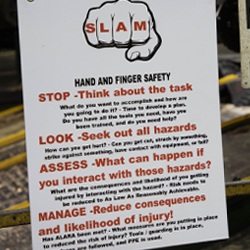
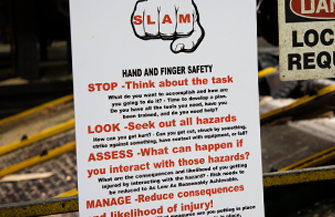
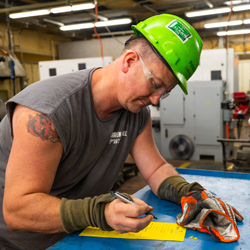

SLAM
The SLAM (Stop, Look, Assess, Manage) process was implemented across all our wood products facilities as a risk assessment program. SLAM reinforces the responsibility of each individual to be accountable for themselves and for those around them and be aware of the risks of hazards before beginning certain tasks. It establishes a process to consciously plan work with safety in mind and reminds Team Members to place a priority on stop-work measures if something appears unsafe or if there is an identified unaddressed hazard. Safety Managers introduced SLAM at all facilities, followed up by on-line training for Team Members. Team Members are asked to complete SLAM cards to improve risk awareness for any upset condition, non-routine task, or a task without a written job safety analysis (JSA). Situational awareness has increased with the implementation of SLAM and numerous corrective actions are being implemented due to the dedicated pause that SLAM provides.
There are four stages to SLAM:
STOP
Stop and consider the work or task. Has anything changed? Do you have the training and are you comfortable doing the task? Do you need a permit?
LOOK
Look for and identify any work hazards before, during, and after the task. Decide what you will do to avoid any hazards. What might happen?
ASSESS
Assess what needs to be done. Do you have the correct knowledge, skills, training, and tools to complete the task safely? What impacts will hazards have?
MANAGE
Manage safety by eliminating identified hazards to reduce severity and likelihood of injury and applying the correct controls or personal protective equipment. If you feel unsafe stop working. Tell your supervisors what would make the situation safe.
In 2023, the SLAM (Stop, Look, Assess, Manage) technique continued to play a pivotal role in enhancing safety protocols across all our wood products facilities. Originally introduced in 2021 as a comprehensive risk assessment program, SLAM has become ingrained in our safety culture, reinforcing the principle of individual accountability and heightened risk awareness among Team Members.
Building upon the foundation laid in the previous year, the implementation of SLAM underwent further refinement and integration into daily operations for all tasks performed by Maintenance at our Warren facility. The Safety Managers continued to ensure that SLAM principles were consistently applied across all facilities, emphasizing the importance of proactive hazard identification and mitigation strategies.
Throughout the year, significant strides were made in bolstering situational awareness among Team Members, resulting in increased responsiveness to potential hazards. The four stages of SLAM - Stop, Look, Assess, Manage - remained the cornerstone of our safety approach, guiding employees through a structured process aimed at minimizing risks and promoting a safer work environment.
The SLAM Card usage across our division provides a valuable snapshot of our commitment to safety and risk management. In 2021, the utilization of SLAM Cards stood at 6,392, indicating a proactive initiation. However, as our sites undergo transformations in equipment and processes and implement Job Hazard Analyses (JHA) for various job tasks, we observed a substantial increase in SLAM Card usage in 2022, reaching 19,494. This surge reflects the heightened emphasis on safety protocols amidst evolving operational landscapes. The SLAM Card usage in 2023 decreased to 12,306, as the integration of JHA and procedural enhancements led to a more systematic approach to risk assessment. This decline underscores the effect of our safety initiatives in fostering a culture of proactive risk management.
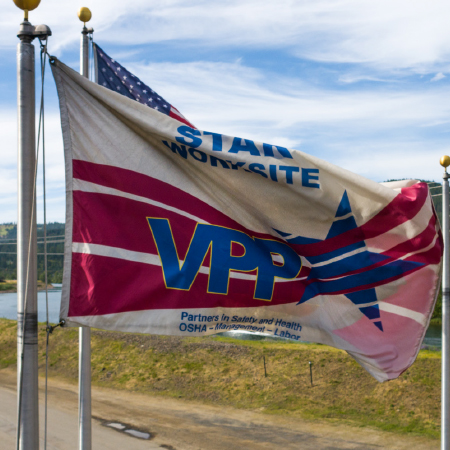
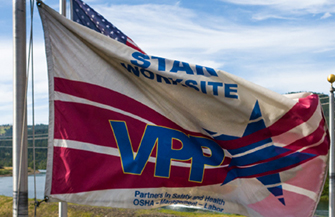
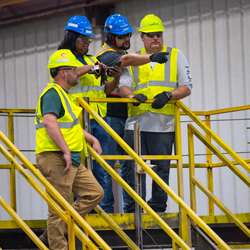
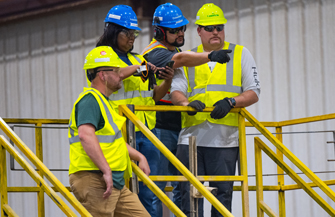
Focus on VPP
The Occupational Safety and Health Administration (OSHA) administers the Voluntary Protection Programs (VPPs), which represent a cooperative relationship to encourage excellence in worksite-based safety and health. VPPs set performance-based criteria for the safety and health system at worksites operated by private industry and federal agencies and, after a worksite applies for admission to the program, OSHA assesses the worksite against these criteria. This is above and beyond normal safety standards and includes a thorough on-site evaluation by a team of OSHA safety and health professionals.
In Michigan, the VPP operates as the Michigan Voluntary Protection Program (MVPP) through the Michigan Occupational Safety and Health Administration (MIOSHA). Our Gwinn, Michigan facility is a Star Worksite in the MVPP (one of 24 Star Worksites in the state of Michigan). Our Gwinn facility first received MVPP Rising Star status in 2010 and achieved MVPP Star status by early 2013. The last re-evaluation was in 2022, with the recommendation from MIOSHA for continued participation as a Star Worksite. During the latest re-evaluation cycle, the Gwinn site was recognized by the MIOSHA team for its safety vision statement: “Through actively caring about the safety and health of our co-workers, the goal of the Gwinn mill is to ensure that all Team Members return home to their families, uninjured every day.” Also recognized as an area of excellence was the implementation of a 90-day Safety Passport onboarding process. This onboarding process gives new Team Members the opportunity to meet members of site leadership to reiterate the site’s safety vision and the resources available for Team Members as they develop in their roles at the mill..
The Minnesota VPP is called MNSTAR. Our Bemidji, Minnesota facility achieved MNSTAR status in 2001 and has maintained its status since then. The last re-evaluation audit was in 2024 with several best practices highlighted, including the facility’s Job Safety program and Environmental Analysis program, SLAM (i.e. Stop, Look, Assess, and Manage) risk assessments, the Bemidji Emergency Response Team, and confined space labeling. One best practice noted was our on-site physical therapy and athletic training program, a proactive approach to prevent soft tissue injuries. Bemidji’s safety efforts earned the facility the Northeastern Lumber Manufacturers Association (NELMA) Safety Award in 2024 based on 2023 performance.
Our St. Maries, Idaho lumber and plywood facilities have set an exceptional standard for safety, and both have been a VPP Star site since 2000. The last re-evaluation was in 2024 during which the auditors highlighted employee engagement by the safety department, the use of frequent personal protective equipment surveys, and extensive lockout - tagout training. The St. Maries complex has focused on an employee-engaged workforce, giving Team Members several opportunities to be involved in safety processes throughout the year. Every month, Team Members are given opportunities to be involved in the safety process including recognizing hazards, using SLAM risk assessments, safety training, reporting near misses, safety committees, new hire training, and reviewing Job Hazard Analysis. St. Maries received an award in 2024 from the Western Wood Products Association for the 2023 lowest one-year incident rate for their district.
We continue to work towards expanding the number of wood products facilities that participate in the VPP in their state. For example, our Waldo, Arkansas facility submitted their VPP application in 2024. Waldo achieved one-year injury free in 2024.
Although it is not certain that we will maintain the state and federal VPP recognitions described above, we believe that participation in these programs is an important part of the health and safety culture at these worksites, and we intend to continue to participate in the VPPs as long as we qualify to do so.
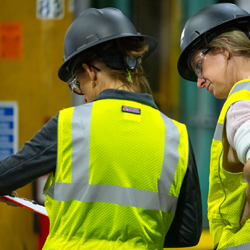
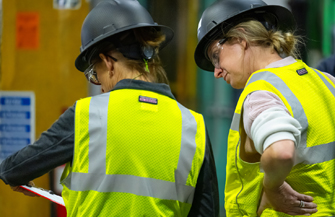
Bemidji Emergency Response Team
Lengthy emergency services response times in rural areas increase the risk that a relatively minor incident grows into a catastrophic event. For example, at the Bemidji mill, fire, medical, or confined space emergencies can take anywhere from 16 to 30 minutes, sometimes longer, for emergency responders to reach. The mill’s safety team took a proactive approach to address this critical gap by establishing the Bemidji Emergency Response Team (B.E.R.T.), a dedicated group of employees trained to respond to on-site medical, fire, and confined space emergencies.
B.E.R.T. was not established in response to a single incident. It was a proactive move to improve emergency response times, reducing incident severity and enhancing overall workplace safety. Led by a certified Emergency Medical Technician, the team includes eight volunteer members who undergo rigorous training in first aid, CPR, rope rescue, and Emergency Medical Response (EMR). Monthly scenario-based training sessions ensure that Team Members are well-prepared to react effectively in real-world emergencies.
The impact of B.E.R.T. became clear almost immediately. It has greatly enhanced the mill’s emergency preparedness by ensuring trained responders are available to act promptly. Beyond operational benefits, the program is contributing to a robust safety culture. Having trained responders on-site has also provided employees with peace of mind. Today, mill policies require that a B.E.R.T. member is called over the radio during any emergency, so that trained personnel can intervene rapidly.
But the benefits don’t stop at the mill’s gates. The life-saving skills that B.E.R.T. members gain extend into their communities, equipping them to respond to emergencies outside of the workplace. The initiative has also strengthened relationships with local emergency responders, with fire and ambulance services conducting site visits to improve coordination in the event of an emergency.
While the program has already proven its value, the team continues to refine and expand its capabilities. Future goals include increasing the number of EMR-certified members, enhancing confined space rescue training, and replicating the initiative at other PotlatchDeltic mills. By investing in proactive safety measures and fostering a culture of emergency readiness, the Bemidji mill has set a new benchmark for workplace safety, one that prioritizes swift action, continuous improvement, and employee well-being.
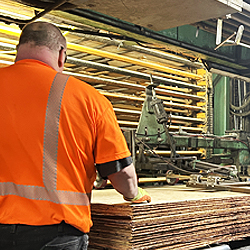
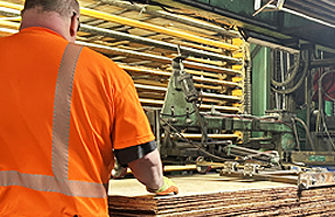
Innovation at St. Maries, Idaho Plywood Facility
PotlatchDeltic’s plywood facility in St. Maries, Idaho was evaluating opportunities to increase safety while remaining focused on providing high quality results for specialty panel markets. Veneer sheets move through the layup line with applied glue, and pre-pressed pieces are then fed into the vertical hot press one at a time to bond the plywood panels through the use of heat, time and pressure. Panels were historically fed into the hot presses manually by Team Members hand feeding them one-by-one into the press. This process created shoulder and hand ergonomic issues, as well as sliver risks. In addition, panels were occasionally damaged as they were pushed into the press resulting in issues like edge delamination.
Team Members were tasked with finding a way to automate the process to increase safety and improve quality. The first mill panel feeder was built by the Maintenance Supervisor at the time. Over time, several versions have been made to perfect the idea and enable it to handle the product in ranges from 3/8” to 1.5” panel thicknesses produced in the mill. Approximately 2.8 million panels that were fed manually are now fed automatically into the hot presses each year. The automated feeding system is a pneumatic feeder on a rail system. Air cylinders on rails extend out and use rollers across the top of the panel to adjust the width and then pull the panel into the press plate with an adjustable backstop to avoid feeding double panels. The press panel feeder designs worked so well that an adapted version of the press feeder systems was then installed on three of the core composers where core veneer is made, eliminating the need for Team Members to lock out and manually place bottom boards.
What started as press feeder automation for ergonomic safety has now resulted in multiple solutions for safety and quality with five of these automated panel feeders incorporated into production at the St. Maries plywood mill. Others in the industry have since adapted to the approach on both presses and composers. The cutting-edge mill implementation and adaptation has been recognized through the 2023 Innovation in Safety Award by the APA – The Engineered Wood Association.
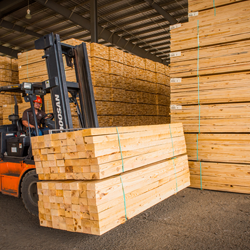
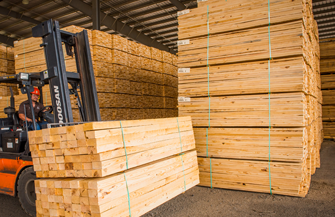
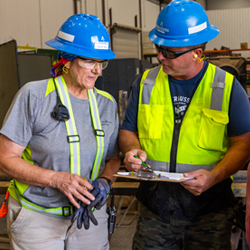
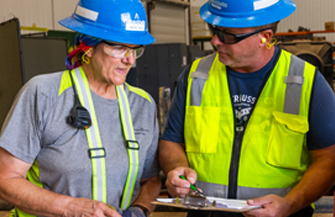
Ola Fire – Lessons Learned
In June 2021, a fire occurred at our Ola, Arkansas wood products facility. The fire began after millwrights completed hot work. The primary log breakdown area of the facility was destroyed in the fire. The internal investigation identified several causes including inadequate hot work preparation and fire watch, poor housekeeping, and inadequate training and accountability. After the fire, an internal safety audit with a hot work and fire protection focus was completed with participation by safety professionals from all the wood products facilities. This resulted in several facility and divisional changes, the implementation of human element risk mitigation measures, and physical improvements related to fire protection.
An increased emphasis was placed on improving fire protection, hot work, and housekeeping processes for all facilities. Fire protection champions were appointed at each facility and a divisional wood products fire chief position has been established to oversee fire suppression systems, testing, processes, and training for facilities. Each facility also has created a fire suppression technician role responsible for fire suppression systems inspection, testing, and maintenance. All fire protection champions have participated in National Fire Protection Association fire protection and systems training. The fire champions conducted inspections of our Arkansas facilities to establish consistent roles and responsibilities and are developing division-wide fire safety standard operating procedures.
Physical improvements at Ola included updated fire pumps, fire equipment, and hoses and an improved fire monitoring and alarm system. Improved procedures for fire protection, particularly related to hot work, were also implemented across all facilities. Changes to hot work procedures included a comprehensive review of hot work training, development of an updated standardized hot work permit that incorporates risk management, and a revised hot work plan. In addition, development of a Job Safety Analysis for hot work and periodic safety audits on hot work were components of the changes.



